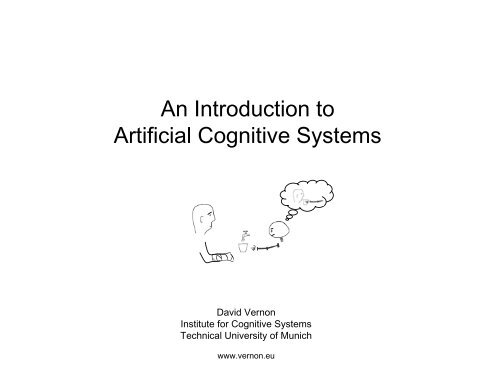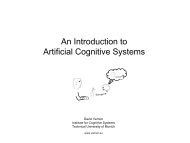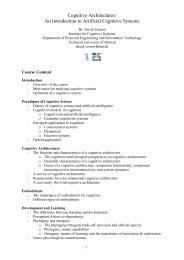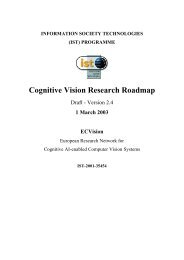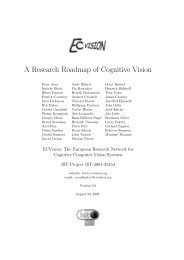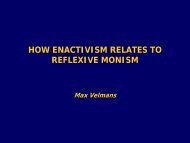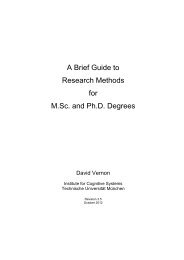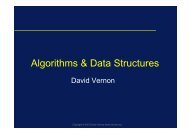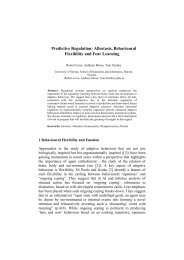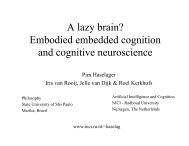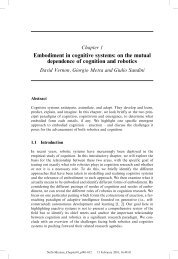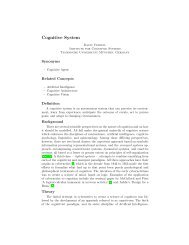The Function and Characteristics of a Cognitive ... - David Vernon
The Function and Characteristics of a Cognitive ... - David Vernon
The Function and Characteristics of a Cognitive ... - David Vernon
Create successful ePaper yourself
Turn your PDF publications into a flip-book with our unique Google optimized e-Paper software.
An Introduction to<br />
Artificial <strong>Cognitive</strong> Systems<br />
<strong>David</strong> <strong>Vernon</strong><br />
Institute for <strong>Cognitive</strong> Systems<br />
Technical University <strong>of</strong> Munich<br />
www.vernon.eu<br />
Copyright © 2012 <strong>David</strong> <strong>Vernon</strong>
Lecture 3<br />
<strong>Cognitive</strong> Architectures<br />
<strong>The</strong> <strong>Function</strong> <strong>and</strong> <strong>Characteristics</strong> <strong>of</strong> a <strong>Cognitive</strong> Architecture<br />
Copyright © 2012 <strong>David</strong> <strong>Vernon</strong>
<strong>Cognitive</strong> Architectures<br />
1. <strong>The</strong> function <strong>and</strong> characteristics <strong>of</strong> a cognitive architecture<br />
- <strong>The</strong> cognitivist <strong>and</strong> emergent perspectives<br />
- Desirable characteristics<br />
- Facets <strong>of</strong> a cognitive architecture:<br />
+ component functionality<br />
+ component interconnectivity<br />
+ system dynamics<br />
2. A survey <strong>of</strong> cognitive architectures<br />
3. Requirements for a developmental cognitive architecture<br />
4. A case study: the iCub cognitive architecture<br />
Copyright © 2012 <strong>David</strong> <strong>Vernon</strong>
COGNITION<br />
Cognitivist<br />
Systems<br />
Hybrid<br />
Systems<br />
Emergent<br />
Systems<br />
<strong>Cognitive</strong><br />
Architecture<br />
<strong>The</strong> term originated with the<br />
work <strong>of</strong> [Newell et al. 1982]<br />
Connectionist<br />
Approaches<br />
Dynamical<br />
Approaches<br />
Enactive<br />
Approaches<br />
Copyright © 2012 <strong>David</strong> <strong>Vernon</strong><br />
[<strong>Vernon</strong>, Metta, S<strong>and</strong>ini 2007]
Cognitivist cognitive architectures<br />
Attempts to create Unified <strong>The</strong>ories <strong>of</strong> Cognition (UTC):<br />
UTCs cover a broad range <strong>of</strong> cognitive issues:<br />
• Attention<br />
• Memory<br />
• Problem solving<br />
• Decision making<br />
• Learning<br />
• …<br />
from several aspects<br />
• Psychology<br />
• Neuroscience<br />
• Computer Science<br />
• … [Byrne 03]<br />
Copyright © 2012 <strong>David</strong> <strong>Vernon</strong>
Cognitivist <strong>Cognitive</strong> Architecture<br />
An embodiment <strong>of</strong> a scientific hypothesis about those aspects <strong>of</strong><br />
human cognition that are<br />
relatively constant over time <strong>and</strong><br />
relatively independent <strong>of</strong> task<br />
[Ritter & Young 01]<br />
Copyright © 2012 <strong>David</strong> <strong>Vernon</strong>
Cognitivist <strong>Cognitive</strong> Architecture<br />
Generic computational model:<br />
• Not domain-specific<br />
• Not task-specific<br />
Knowledge provides the required specificity<br />
<strong>Cognitive</strong> Architecture + Knowledge = <strong>Cognitive</strong> Model<br />
[Lehman et al 97, also Anderson & Labiere 98, Newell 90]<br />
Copyright © 2012 <strong>David</strong> <strong>Vernon</strong>
Cognitivist <strong>Cognitive</strong> Architecture<br />
• <strong>The</strong>ory <strong>of</strong> the fixed set <strong>of</strong> mechanisms <strong>and</strong> structures<br />
• Needs content to get behaviour<br />
architecture<br />
for<br />
architecture<br />
for<br />
TASK<br />
APPLICATION<br />
HARDWARE<br />
content<br />
for<br />
content<br />
for<br />
BEHAVIOR = ARCHITECTURE X CONTENT<br />
Factor out what’s common across cognitive behaviours<br />
across the phenomena explained by micro-theories<br />
Lehman et al 97, also Anderson & Labiere 98, Newell 90<br />
Copyright © 2012 <strong>David</strong> <strong>Vernon</strong>
Cognitivist <strong>Cognitive</strong> Architecture<br />
Overall structure <strong>and</strong> organization <strong>of</strong> a cognitive system<br />
• Essential Modules<br />
• Essential relations between these modules<br />
• Essential algorithmic <strong>and</strong> representational details in each module<br />
[Sun 2007]<br />
Copyright © 2012 <strong>David</strong> <strong>Vernon</strong><br />
[GMU-BICA Architecture: Samsonovich 2005]
Cognitivist <strong>Cognitive</strong> Architecture<br />
Commitment to formalisms for<br />
• Short-term & long-term memories that store the agent’s beliefs, goals,<br />
<strong>and</strong> knowledge<br />
• Representation & organization <strong>of</strong> structures embedded in memory<br />
• <strong>Function</strong>al processes that operate on these structures<br />
• Performance / utilization<br />
• Learning<br />
• Programming language to construct systems embodying the architectures<br />
assumptions<br />
[Langley 05, Langley 06, Langley et al. 09]<br />
Copyright © 2012 <strong>David</strong> <strong>Vernon</strong>
Emergent <strong>Cognitive</strong> Architecture<br />
Emergent approaches focus on development<br />
• From a primitive state<br />
• To fully cognitive state, over the system’s lifetime<br />
Copyright © 2012 <strong>David</strong> <strong>Vernon</strong>
Emergent <strong>Cognitive</strong> Architecture<br />
<strong>The</strong> cognitive architecture is the system’s<br />
phylogenetic configuration<br />
• <strong>The</strong> basis for ontogenesis: growth <strong>and</strong> development<br />
– Innate skills<br />
– Core knowledge (cf. Spelke)<br />
• A structure in which to embed mechanisms for<br />
– Perception<br />
– Action<br />
– Adaptation<br />
– Anticipation<br />
– Motivation<br />
– … Development <strong>of</strong> all these<br />
Copyright © 2012 <strong>David</strong> <strong>Vernon</strong>
Emergent <strong>Cognitive</strong> Architecture<br />
Focus on<br />
• Autonomy-preserving anticipatory <strong>and</strong><br />
adaptive skill construction<br />
• <strong>The</strong> morphology <strong>of</strong> the physical body<br />
in which the architecture is embedded<br />
Copyright © 2012 <strong>David</strong> <strong>Vernon</strong>
Desirable <strong>Characteristics</strong> <strong>of</strong> a<br />
<strong>Cognitive</strong> Architecture<br />
Copyright © 2012 <strong>David</strong> <strong>Vernon</strong>
Desirable <strong>Characteristics</strong><br />
Desiderata for <strong>Cognitive</strong> Architectures [Sun 2004]<br />
1. Ecological realism<br />
2. Bio-evolutionary realism<br />
3. <strong>Cognitive</strong> realism<br />
4. Inclusiveness <strong>of</strong> prior perspectives<br />
Copyright © 2012 <strong>David</strong> <strong>Vernon</strong>
Desirable <strong>Characteristics</strong><br />
Concurrent conflicting goals<br />
Ecological realism<br />
Everyday activities<br />
Embodied<br />
Copyright © 2012 <strong>David</strong> <strong>Vernon</strong><br />
[Sun 2004]
Desirable <strong>Characteristics</strong><br />
Bio-evolutionary realism<br />
Human intelligence reducible to<br />
model <strong>of</strong> animal intelligence<br />
Copyright © 2012 <strong>David</strong> <strong>Vernon</strong><br />
[Sun 2004]
Desirable <strong>Characteristics</strong><br />
Human psychology<br />
<strong>Cognitive</strong> realism<br />
Human neuroscience<br />
Philosophy<br />
Copyright © 2012 <strong>David</strong> <strong>Vernon</strong>
Desirable <strong>Characteristics</strong><br />
Draw on older models<br />
Prior perspectives<br />
Subsume older models<br />
Supercede older models<br />
Copyright © 2012 <strong>David</strong> <strong>Vernon</strong><br />
[Sun 2004]
Desirable <strong>Characteristics</strong><br />
Act & React …<br />
Simple conceptual schemas<br />
Behavioural <strong>Characteristics</strong><br />
Simple weighing <strong>of</strong> alternatives<br />
Temporal sequence <strong>of</strong> actions<br />
Gradually-learned routine behaviours<br />
… trial-<strong>and</strong>-error adaptation<br />
Copyright © 2012 <strong>David</strong> <strong>Vernon</strong><br />
[Sun 2004]
Desirable <strong>Characteristics</strong><br />
Implicit bottom-up learning<br />
<strong>Cognitive</strong> <strong>Characteristics</strong><br />
Explicit symbolic learning<br />
<strong>Function</strong>al or physical modularity<br />
Copyright © 2012 <strong>David</strong> <strong>Vernon</strong><br />
[Sun 2004]
Desirable <strong>Characteristics</strong><br />
<strong>Cognitive</strong> architectures: Research issues <strong>and</strong> challenges<br />
<strong>Cognitive</strong> architectures:<br />
Research issues <strong>and</strong><br />
challenges<br />
1. Recognition & categorization<br />
2. Decision-making & choice<br />
3. Perception & situation assessment<br />
4. Prediction & monitoring<br />
5. Problem solving & planning<br />
6. Reasoning & belief maintenance<br />
7. Execution & action<br />
8. Interaction & communication<br />
9. Remembering, reflection, & learning<br />
[Langley et al. 2009]<br />
Copyright © 2012 <strong>David</strong> <strong>Vernon</strong>
Desirable <strong>Characteristics</strong><br />
<strong>The</strong> importance <strong>of</strong> cognitive architectures …<br />
<strong>The</strong> importance <strong>of</strong><br />
<strong>Cognitive</strong> architectures:<br />
An analysis based<br />
On Clarion<br />
1. Perception<br />
2. Categorization<br />
3. Multiple representations<br />
4. Multiple types <strong>of</strong> memory<br />
5. Decision making<br />
6. Reasoning<br />
7. Planning<br />
8. Problem solving<br />
9. Meta-cognition<br />
10.Communication<br />
11.Action control <strong>and</strong> execution<br />
12.Several types <strong>of</strong> learning<br />
[Sun 2007]<br />
<strong>The</strong> importance <strong>of</strong> the interconnectivity between these processes<br />
Copyright © 2012 <strong>David</strong> <strong>Vernon</strong>
Desirable <strong>Characteristics</strong><br />
Cogaff <strong>Cognitive</strong> Architecture Schema<br />
[Sloman 2000]<br />
H-Cogaff <strong>Cognitive</strong> Architecture<br />
[Sloman 2001]<br />
Copyright © 2012 <strong>David</strong> <strong>Vernon</strong>
Desirable <strong>Characteristics</strong><br />
<strong>Cognitive</strong> Architectures <strong>of</strong> Developmental Systems<br />
[Krichmar & Edelman 2005, 2006]<br />
1. Address connectivity <strong>and</strong> interaction between circuits/regions in the brain<br />
2. Effect perceptual categorization, without a priori knowledge<br />
(a model generator, rather than a model fitter, cf [Weng 04])<br />
3. Embodied & capable <strong>of</strong> exploration<br />
4. Minimal set <strong>of</strong> innate behaviours<br />
5. Value system (set <strong>of</strong> motivations) to govern development<br />
Copyright © 2012 <strong>David</strong> <strong>Vernon</strong>
Facets <strong>of</strong> a <strong>Cognitive</strong> Architecture<br />
• Component functionality<br />
• Component interconnectivity<br />
• System dynamics<br />
Copyright © 2012 <strong>David</strong> <strong>Vernon</strong>
Facets <strong>of</strong> a <strong>Cognitive</strong> Architecture<br />
• Component functionality<br />
– Specification<br />
• <strong>Function</strong>ality<br />
• <strong>The</strong>oretical foundations<br />
• Computational model<br />
• Information representation<br />
• <strong>Function</strong>al model (e.g. functional decomposition)<br />
• Data model (e.g. data dictionary or ER diagram)<br />
• Process-flow model (e.g. DFD diagram)<br />
• Behavioural model (e.g. State transition diagram)<br />
• Interface: input, output, protocols<br />
– Design choices: algorithms <strong>and</strong> data-structures<br />
– Implementation<br />
– API specification<br />
Copyright © 2012 <strong>David</strong> <strong>Vernon</strong>
Facets <strong>of</strong> a <strong>Cognitive</strong> Architecture<br />
• Component interconnectivity<br />
– Data flow<br />
– Control flow<br />
Copyright © 2012 <strong>David</strong> <strong>Vernon</strong>
Facets <strong>of</strong> a <strong>Cognitive</strong> Architecture<br />
• System dynamics<br />
– Cognitivist cognitive architectures<br />
• Add knowledge to determine the dynamics <strong>and</strong> flow <strong>of</strong> information<br />
– Emergent cognitive architectures<br />
• Not so straightforward … can’t just add knowledge<br />
Copyright © 2012 <strong>David</strong> <strong>Vernon</strong>
Facets <strong>of</strong> a <strong>Cognitive</strong> Architecture<br />
• System dynamics<br />
– Emergent cognitive architectures<br />
• Dynamics result from interaction between the components<br />
– Driven by an embedded value system that governs the developmental<br />
process<br />
– Not by explicit production rules that encapsulate prior declarative <strong>and</strong><br />
procedural knowledge<br />
• Need to specify the interactions between components<br />
– Small ensembles (at least)<br />
– Whole system (ideally)<br />
• This is a tough challenge<br />
– Assemblies <strong>of</strong> loosely-coupled concurrent processes<br />
– Operating asynchronously<br />
– Without a central control unit<br />
– Dynamics depend on circular causality<br />
Copyright © 2012 <strong>David</strong> <strong>Vernon</strong>
• Organizational decomposition<br />
• Explicit inter-connectivity<br />
• Representational formalism<br />
• Algorithmic formalism<br />
Learn<br />
Perceive<br />
COGNITION<br />
Anticipate<br />
Cognitivist<br />
Systems<br />
• Framework in which<br />
to embed knowledge<br />
• Memories<br />
• Formalisms for learning<br />
• Programming mechanism<br />
Adapt<br />
Hybrid<br />
Systems<br />
Act<br />
Emergent<br />
Systems<br />
Phylogeny - basis for development:<br />
• Innate skills<br />
• Core knowledge<br />
• Formalism for autonomy<br />
• Formalism for development<br />
Copyright © 2012 <strong>David</strong> <strong>Vernon</strong>
Recommended Reading<br />
Langley, P.: <strong>Cognitive</strong> architectures <strong>and</strong> general intelligent systems.<br />
AI Magazine 27(2), 33–44 (2006).<br />
Langley, P., Laird, J.E., Rogers, S.: <strong>Cognitive</strong> architectures:<br />
Research issues <strong>and</strong> challenges. <strong>Cognitive</strong> Systems Research<br />
10(2), 141–160 (2009).<br />
Sun, R.: <strong>The</strong> importance <strong>of</strong> cognitive architectures: an analysis<br />
based on clarion. Journal <strong>of</strong> Experimental & <strong>The</strong>oretical Artificial<br />
Intelligence 19(2), 159–193 (2007).<br />
Sun, R.: Desiderata for cognitive architectures. Philosophical<br />
Psychology 17(3), 341–373 (2004).<br />
Copyright © 2012 <strong>David</strong> <strong>Vernon</strong>


